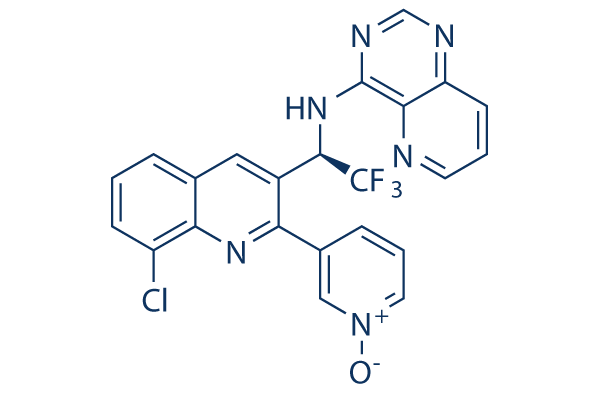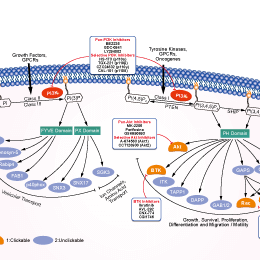
- Bioactive Compounds
- By Signaling Pathways
- PI3K/Akt/mTOR
- Epigenetics
- Methylation
- Immunology & Inflammation
- Protein Tyrosine Kinase
- Angiogenesis
- Apoptosis
- Autophagy
- ER stress & UPR
- JAK/STAT
- MAPK
- Cytoskeletal Signaling
- Cell Cycle
- TGF-beta/Smad
- DNA Damage/DNA Repair
- Compound Libraries
- Popular Compound Libraries
- Customize Library
- Clinical and FDA-approved Related
- Bioactive Compound Libraries
- Inhibitor Related
- Natural Product Related
- Metabolism Related
- Cell Death Related
- By Signaling Pathway
- By Disease
- Anti-infection and Antiviral Related
- Neuronal and Immunology Related
- Fragment and Covalent Related
- FDA-approved Drug Library
- FDA-approved & Passed Phase I Drug Library
- Preclinical/Clinical Compound Library
- Bioactive Compound Library-I
- Bioactive Compound Library-Ⅱ
- Kinase Inhibitor Library
- Express-Pick Library
- Natural Product Library
- Human Endogenous Metabolite Compound Library
- Alkaloid Compound LibraryNew
- Angiogenesis Related compound Library
- Anti-Aging Compound Library
- Anti-alzheimer Disease Compound Library
- Antibiotics compound Library
- Anti-cancer Compound Library
- Anti-cancer Compound Library-Ⅱ
- Anti-cancer Metabolism Compound Library
- Anti-Cardiovascular Disease Compound Library
- Anti-diabetic Compound Library
- Anti-infection Compound Library
- Antioxidant Compound Library
- Anti-parasitic Compound Library
- Antiviral Compound Library
- Apoptosis Compound Library
- Autophagy Compound Library
- Calcium Channel Blocker LibraryNew
- Cambridge Cancer Compound Library
- Carbohydrate Metabolism Compound LibraryNew
- Cell Cycle compound library
- CNS-Penetrant Compound Library
- Covalent Inhibitor Library
- Cytokine Inhibitor LibraryNew
- Cytoskeletal Signaling Pathway Compound Library
- DNA Damage/DNA Repair compound Library
- Drug-like Compound Library
- Endoplasmic Reticulum Stress Compound Library
- Epigenetics Compound Library
- Exosome Secretion Related Compound LibraryNew
- FDA-approved Anticancer Drug LibraryNew
- Ferroptosis Compound Library
- Flavonoid Compound Library
- Fragment Library
- Glutamine Metabolism Compound Library
- Glycolysis Compound Library
- GPCR Compound Library
- Gut Microbial Metabolite Library
- HIF-1 Signaling Pathway Compound Library
- Highly Selective Inhibitor Library
- Histone modification compound library
- HTS Library for Drug Discovery
- Human Hormone Related Compound LibraryNew
- Human Transcription Factor Compound LibraryNew
- Immunology/Inflammation Compound Library
- Inhibitor Library
- Ion Channel Ligand Library
- JAK/STAT compound library
- Lipid Metabolism Compound LibraryNew
- Macrocyclic Compound Library
- MAPK Inhibitor Library
- Medicine Food Homology Compound Library
- Metabolism Compound Library
- Methylation Compound Library
- Mouse Metabolite Compound LibraryNew
- Natural Organic Compound Library
- Neuronal Signaling Compound Library
- NF-κB Signaling Compound Library
- Nucleoside Analogue Library
- Obesity Compound Library
- Oxidative Stress Compound LibraryNew
- Plant Extract Library
- Phenotypic Screening Library
- PI3K/Akt Inhibitor Library
- Protease Inhibitor Library
- Protein-protein Interaction Inhibitor Library
- Pyroptosis Compound Library
- Small Molecule Immuno-Oncology Compound Library
- Mitochondria-Targeted Compound LibraryNew
- Stem Cell Differentiation Compound LibraryNew
- Stem Cell Signaling Compound Library
- Natural Phenol Compound LibraryNew
- Natural Terpenoid Compound LibraryNew
- TGF-beta/Smad compound library
- Traditional Chinese Medicine Library
- Tyrosine Kinase Inhibitor Library
- Ubiquitination Compound Library
-
Cherry Picking
You can personalize your library with chemicals from within Selleck's inventory. Build the right library for your research endeavors by choosing from compounds in all of our available libraries.
Please contact us at [email protected] to customize your library.
You could select:
- Antibodies
- Bioreagents
- qPCR
- 2x SYBR Green qPCR Master Mix
- 2x SYBR Green qPCR Master Mix(Low ROX)
- 2x SYBR Green qPCR Master Mix(High ROX)
- Protein Assay
- Protein A/G Magnetic Beads for IP
- Anti-Flag magnetic beads
- Anti-Flag Affinity Gel
- Anti-Myc magnetic beads
- Anti-HA magnetic beads
- Magnetic Separator
- Poly DYKDDDDK Tag Peptide lyophilized powder
- Protease Inhibitor Cocktail
- Protease Inhibitor Cocktail (EDTA-Free, 100X in DMSO)
- Phosphatase Inhibitor Cocktail (2 Tubes, 100X)
- Cell Biology
- Cell Counting Kit-8 (CCK-8)
- Animal Experiment
- Mouse Direct PCR Kit (For Genotyping)
- New Products
- Contact Us
Seletalisib (UCB-5857)
Seletalisib (UCB-5857) is a novel small-molecule inhibitor of PI3Kδ with an IC50 value of 12 nM and shows significant selectivity to PI3Kδ with respect to the other class I PI3K isoforms (between 24- and 303-fold).

Seletalisib (UCB-5857) Chemical Structure
CAS No. 1362850-20-1
Purity & Quality Control
Seletalisib (UCB-5857) Related Products
Signaling Pathway
Biological Activity
| Description | Seletalisib (UCB-5857) is a novel small-molecule inhibitor of PI3Kδ with an IC50 value of 12 nM and shows significant selectivity to PI3Kδ with respect to the other class I PI3K isoforms (between 24- and 303-fold). | ||||
|---|---|---|---|---|---|
| Targets |
|
| In vitro | ||||
| In vitro | Seletalisib is a potent, ATP-competitive, and selective PI3Kδ inhibitor able to block protein kinase B (AKT) phosphorylation following activation of the B-cell receptor in a B-cell line. Moreover, seletalisib inhibited N-formyl peptide-stimulated but not phorbol myristate acetate–stimulated superoxide release from human neutrophils, consistent with a PI3Kδ-specific activity. Findings from cellular assays of adaptive immunity demonstrated that seletalisib blocks human T-cell production of several cytokines from activated T-cells. Additionally, seletalisib inhibited B-cell proliferation and cytokine release. In human whole blood assays, seletalisib inhibited CD69 expression upon B-cell activation and anti-IgE-mediated basophil degranulation. From 239 kinases screened, seletalisib at a concentration of 10 μM showed no inhibitory activity greater than 47% (MAP4K4) against non-PI3K kinase enzymes. Against nonkinase enzymes, seletalisib showed weak activities against phosphodiesterase (PDE)3A, PDE2A1, and PDE4D2, with inhibition varying between 32 and 74% at 10 μM. When screened at a concentration of 10 μM against 55 receptors and ion channels, the highest inhibitory activity of seletalisib observed was 20%. One receptor, neuropeptide Y receptor (Y1) showed 54% activation. In vitro receptor binding and enzyme assays across a broad range of target classes showed that seletalisib is selective for PI3Kδ. Seletalisib potently inhibited the phosphorylation of AKT following anti-IgM stimulation of the BCR on Ramos cells with an IC50 of 15 nM[1]. When profiled in a wide range of primary cell assay systems, including fibroblasts, epithelial, endothelial and vascular smooth muscle cells, seletalisib showed significant activity only in those systems containing lymphocytes, demonstrating its functional selectivity towards PI3Kδ-expressing cells[2]. |
|||
|---|---|---|---|---|
| Kinase Assay | In Vitro Kinase Activity Assays and Off-Target Profiling | |||
| The activities of seletalisib and the pan-PI3K inhibitor UCB1370037 were tested in biochemical kinase assays of the PI3Kα, PI3Kβ, PI3Kδ and PI3Kγ (manufactured in-house) isoforms. Competitive time-resolved (TR) fluorescence resonance energy transfer (FRET) assays using a four-step PI3K assay reagent kit were performed. In this assay, PI3K activity is measured by the detection of phosphatidylinositol triphosphate (PIP3) as follows: A complex is formed between biotinylated PIP3 and a glutathione S-transferase (GST)-tagged pleckstrin homology–domain protein, which are detected by streptavidin-allophycocyanin (APC) and europium-labeled anti-GST antibody, respectively. Proximity of the two fluorophores results in a stable TR-FRET signal. The production of unlabeled PIP3 by PI3K in the kinase reaction results in competitive inhibition of the complex and therefore the FRET signal. Briefly, 2 μl of compound was added to wells containing 8 μl of a mixture containing phosphatidylinositol bisphosphate (PIP2) substrate and ATP, before addition of 10 μl of PI3K (prediluted to the required concentration). The final assay concentrations of ATP and PIP2 substrate were 2 μM and 10 μM, respectively. The final assay concentration of PI3K enzymes was 1–8 nM depending on batch activity. The final assay concentration of DMSO was 2.0%. The plate was incubated at room temperature for 30 minutes before addition of stop buffer and detection buffer according to manufacturer instructions, and the plate was then incubated for a further 6 hours at room temperature. TR-FRET measurements were performed on an Analyst GT plate reader. The ATP concentration dependence of the activity of seletalisib against PI3Kδ was established by running the assay in the presence of varying ATP concentrations (2, 40, 200, and 1000 μM). The final assay concentrations of PI3Kδ and PIP2 substrate in these assays were 1 nM and 25 μM, respectively. | ||||
| Cell Research | Cell lines | Ramos B-cell line | ||
| Concentrations | 0.1 nM-10 μM | |||
| Incubation Time | 10 min | |||
| Method | Serially diluted seletalisib and goat anti-human F(ab)2 IgM in serum-free RPMI 1640 were added to Ramos cells plated in serum-free RPMI 1640. The plate was incubated for 10 minutes, chilled on ice, and the cells pelleted by centrifugation. Cellular phosphorylated AKT was detected by MSD assay. |
|||
| In Vivo | ||
| In vivo | Seletalisib shows dose-dependent inhibition in an in vivo rat model of anti-CD3-antibody-induced interleukin 2 release. Analysis of the relationship between inhibition of IL-2 release and seletalisib blood concentration, using combined data across experiments, demonstrated that seletalisib has potent in vivo effects with an estimated IC50 value of <10 nM[1]. In first-in-man studies, mean seletalisib plasma concentration-time profiles increased with increasing dose after single and multiple dosing, with no major deviations from dose proportionality. There was no unexpected accumulation or loss of exposure after multiple dosing (time-independent pharmacokinetic (PK) profile) and apparent t1/2 values (approx. 20h) were supportive of once-daily dosing[2]. |
|
|---|---|---|
| Animal Research | Animal Models | Adult Lewis rats (male, 6-8 weeks of age) |
| Dosages | 0.1-10 mg/kg in 500 μl volume | |
| Administration | via oral gavage | |
| NCT Number | Recruitment | Conditions | Sponsor/Collaborators | Start Date | Phases |
|---|---|---|---|---|---|
| NCT02207595 | Completed | Healthy Volunteers |
UCB Celltech|Parexel|UCB Pharma |
August 2014 | Phase 1 |
| NCT02303509 | Completed | Psoriasis |
UCB Pharma|Parexel |
August 2013 | Phase 1 |
Chemical Information & Solubility
| Molecular Weight | 482.85 | Formula | C23H14ClF3N6O |
| CAS No. | 1362850-20-1 | SDF | -- |
| Smiles | C1=CC2=CC(=C(N=C2C(=C1)Cl)C3=C[N+](=CC=C3)[O-])C(C(F)(F)F)NC4=NC=NC5=C4N=CC=C5 | ||
| Storage (From the date of receipt) | 3 years -20°C powder | ||
|
In vitro |
DMSO : 97 mg/mL ( (200.89 mM) Moisture-absorbing DMSO reduces solubility. Please use fresh DMSO.) Ethanol : 97 mg/mL Water : Insoluble |
Molecular Weight Calculator |
|
In vivo Add solvents to the product individually and in order. |
In vivo Formulation Calculator |
||||
Preparing Stock Solutions
Molarity Calculator
In vivo Formulation Calculator (Clear solution)
Step 1: Enter information below (Recommended: An additional animal making an allowance for loss during the experiment)
mg/kg
g
μL
Step 2: Enter the in vivo formulation (This is only the calculator, not formulation. Please contact us first if there is no in vivo formulation at the solubility Section.)
% DMSO
%
% Tween 80
% ddH2O
%DMSO
%
Calculation results:
Working concentration: mg/ml;
Method for preparing DMSO master liquid: mg drug pre-dissolved in μL DMSO ( Master liquid concentration mg/mL, Please contact us first if the concentration exceeds the DMSO solubility of the batch of drug. )
Method for preparing in vivo formulation: Take μL DMSO master liquid, next addμL PEG300, mix and clarify, next addμL Tween 80, mix and clarify, next add μL ddH2O, mix and clarify.
Method for preparing in vivo formulation: Take μL DMSO master liquid, next add μL Corn oil, mix and clarify.
Note: 1. Please make sure the liquid is clear before adding the next solvent.
2. Be sure to add the solvent(s) in order. You must ensure that the solution obtained, in the previous addition, is a clear solution before proceeding to add the next solvent. Physical methods such
as vortex, ultrasound or hot water bath can be used to aid dissolving.
Tech Support
Answers to questions you may have can be found in the inhibitor handling instructions. Topics include how to prepare stock solutions, how to store inhibitors, and issues that need special attention for cell-based assays and animal experiments.
Tel: +1-832-582-8158 Ext:3
If you have any other enquiries, please leave a message.
* Indicates a Required Field
Tags: buy Seletalisib (UCB-5857) | Seletalisib (UCB-5857) supplier | purchase Seletalisib (UCB-5857) | Seletalisib (UCB-5857) cost | Seletalisib (UCB-5857) manufacturer | order Seletalisib (UCB-5857) | Seletalisib (UCB-5857) distributor







































